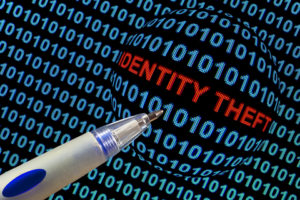Synthetic Identity Theft: What Is It?
You might know what identity theft is. It’s when someone takes someone else’s personal and private information so that they can get something out of it…namely, money. What you might not know is what synthetic identity theft is. The goal is the same, but it’s a little different.

In the case of synthetic identity theft, a person makes up a new and fake identity by mixing up information from a real person with information that they create. You might not immediately see that this is a bad thing, but it can be pretty devastating.
Here are three ways that hackers can create a synthetic identity:
They Can Create a New Credit Profile
By far, the most common way that the bad guys use a synthetic identity is to create a new credit profile. Basically, they use a valid Social Security number, which they take from the victim, and pair it with a made-up name. Then, they start applying for credit with this information. Typically, these applications will get denied, but during this process, a credit profile is created. Even with poor credit, there are companies that give credit to people with bad credit, so the hackers know they can get a few hundred dollars out of this which can turn into a few thousand dollars or more.
They Can Piggyback
Another thing that people do with synthetic identity is a practice known as the piggyback. At a basic level, they look for individuals with great credit, and then they access their account. When they do this, they add a fake person as an authorized user. However, they don’t use this account. Instead, they bide their time and let it sit. While they wait, the major credit card agencies create a report of this synthetic identity, and the criminal hacker can use this new, great credit profile to apply for loans and credit cards.
They Practice Data Furnishing
Finally, they might use data furnishing. This is an effective, sophisticated method, and it requires someone else to help. Basically, the hacker needs access to someone like a manager or a small business owner from an established business. The company is already well-known, and it is approved to offer info on their customers…which they give to the hackers. A setup like this takes several months to set up, but once it is established, it can make the thieves a lot of cash.
Currently, it’s difficult to pinpoint how much financial impact these synthetic identities have, although it is thought that it could be billions of dollars in losses. For someone who gets into the business of identity theft, this could mean billions of dollars. Thankfully, there are a number of things that you can do to protect yourself, including being careful about what type of information you are sharing, especially when it comes to social media. Also, consider a credit freeze and ID theft protection, and make sure that you check your credit report regularly.
Written by Robert Siciliano, CEO of Credit Parent, Head of Training & Security Awareness Expert at Protect Now, #1 Best Selling Amazon author, Media Personality & Architect of CSI Protection Certification.


 There is really no difference than labeling a food product as being “natural,” even though it is not “organic.” In the best case, the info is incorrect, and at the worst, it is miss leading and an outright lie.
There is really no difference than labeling a food product as being “natural,” even though it is not “organic.” In the best case, the info is incorrect, and at the worst, it is miss leading and an outright lie. Here is the situation. You cannot possibly protect yourself from every type of identity theft out there, and when you can, it really requires a lot of work. No matter what, it’s going to be time-consuming, can cost you money, and even make you pretty anxious.
Here is the situation. You cannot possibly protect yourself from every type of identity theft out there, and when you can, it really requires a lot of work. No matter what, it’s going to be time-consuming, can cost you money, and even make you pretty anxious.
 The study also showed a shift in how ID theft fraud was being done. Credit card accounts were the most common targets for new account fraud, we also see that there is a big uptick in other accounts being targeted, including PayPal accounts and e-commerce merchant accounts. We can also see that more than 30% of consumers in the US were notified that their information was part of a data breach, which is 12% higher than the year before. Social Security numbers also seem to be a favorite of ID thieves, as are credit card numbers. We also see that due to these breaches, consumers are becoming less trusting when it comes to companies and financial institutions that are storing personal data.
The study also showed a shift in how ID theft fraud was being done. Credit card accounts were the most common targets for new account fraud, we also see that there is a big uptick in other accounts being targeted, including PayPal accounts and e-commerce merchant accounts. We can also see that more than 30% of consumers in the US were notified that their information was part of a data breach, which is 12% higher than the year before. Social Security numbers also seem to be a favorite of ID thieves, as are credit card numbers. We also see that due to these breaches, consumers are becoming less trusting when it comes to companies and financial institutions that are storing personal data. This is no different than labeling a food as “natural,” even though it is not actually “organic.” At best, this is incorrect information. At worst, it’s a total lie.
This is no different than labeling a food as “natural,” even though it is not actually “organic.” At best, this is incorrect information. At worst, it’s a total lie. There are a number of ways that an employee can steal:
There are a number of ways that an employee can steal: How Does This Happen?
How Does This Happen? In actuality, Symansky was really Richard Hoagland, who’d been married twice before, who had lived in Indiana and then mysteriously disappeared and was eventually presumed dead. He had stolen the real Terry Jude Symansky’s identity and got away with this for 25 years—until he was busted by Symansky’s nephew.
In actuality, Symansky was really Richard Hoagland, who’d been married twice before, who had lived in Indiana and then mysteriously disappeared and was eventually presumed dead. He had stolen the real Terry Jude Symansky’s identity and got away with this for 25 years—until he was busted by Symansky’s nephew.























